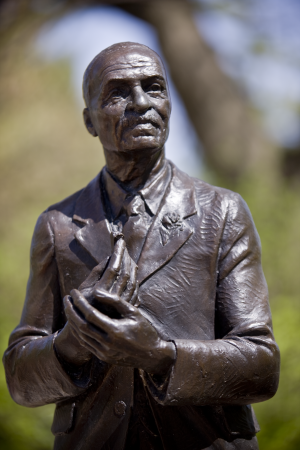Students with a focused interest or a passion for social justice found Iowa’s agricultural college to be a place for growth and development. Many have made significant contributions to society.
 Improving Quality of Life
Improving Quality of Life
George Washington Carver had a keen interest in plants at an early age. While studying piano and painting at Simpson College, his art teacher encouraged him to pursue education related to his horticultural talents. He became the first African American to enroll at Iowa State College (1891), flourished in his studies and numerous student activities, and through his friendship with a young Henry A. Wallace inspired the youth to develop a love for plants.
While at Iowa State, Carver studied genetics and horticulture; he taught botany as a Master’s student. He was hired away from Iowa State by Tuskegee Normal and Industrial Institute and continued his plant science research in production agriculture, soil depletion, and value added products with the purpose of improving the quality of life in rural America.
Gaining Voting Rights for Women
Carrie Lane Chapman Catt entered Iowa State College in 1877 and graduated as the only woman in a class of 17. One of her most well-known accomplishments as a young college student was the formation of a women’s course in military training. It also is an early example of her political convictions and tenacious nature. Having heard the school commandant talk about the value of compulsory military exercise for men and believing the exercise would benefit women, she led a delegation of females to request instruction for a group for women. The result was Company G (G for girls).
Carrie Lane graduated college in 1880 and took the job as Mason City High School principal. During that time she met her newspaper editor husband, Leo Chapman, and began writing a column titled “Woman’s World,” in which she shared views expressed by women she interviewed during door-to-door surveying. Women overwhelmingly favored women’s suffrage, giving her data to reference as she began the crusade for women’s right to vote in 1886 – which she did until the vote was attained. Catt also was responsible for the formation of the League of Women Voters.
Creating First Digital Computer
John Atanasoff, professor of mathematics and physics, assisted by electrical engineering student Clifford Berry, designed and built the world’s first electronic digital computer at Iowa State College between 1935 and 1942. Atanasoff, tired of seeing his graduate students spend so much time using mechanical calculating machines to solve long linear equations, wanted to invent something that would solve these equations much more quickly.
The prototype constructed in October 1939 was the first electronic calculating machine to use binary numbers, direct logic for calculations and a regenerative memory. The Atanasoff-Berry Computer (ABC) embodied concepts that would be central to the future development of computers.
Preserving Iowa's Plants
Ada Hayden grew up in rural Ames, loving the prairie that surrounded her. She earned a bachelor’s degree in botany from Iowa State College in 1908; in 1918, she was the first woman (and the fourth student) to receive a doctorate from the institution. Hayden taught botany as an instructor (1910-18) and professor (1919-50) and was named curator of the herbarium (1947-50). During her time at Iowa State she added more than 40,000 specimens to the herbarium and applied her skills photographing and illustrating plants.
Throughout her professional life, Hayden fought for the preservation of native prairie, and assisted with the state park movement in Iowa, writing numerous articles advocating for both. Today, Ada Hayden Heritage Park north of Ames, near her childhood home, is a testament to her commitment to scientific preserves.
Improving Agriculture
Henry A. Wallace’s interest in plants was encouraged by his mother and George W. Carver, who as an Iowa State Agricultural College student, lived with the Wallace family. At age 15, young Henry participated in a corn judging short course and questioned the value of beauty in predicting yield from an ear of corn. The instructor challenged him to plant an ear-row trial the next year and compare yields – this was the start of his life-long involvement in the improvement of corn through genetic selection.
He graduated from high school in 1906, continued his experiments with corn, and began writing for Wallaces’ Farmer while attending Iowa State College. After college graduation he went to work for the paper and continued experimenting with corn. He used the paper to report on the development of hybrid corn, and founded the Hi-Bred Corn Company. Wallace provided many benefits to agriculture as the editor of Wallace’s Farmer, U.S. secretary of agriculture, and vice president under President Franklin D. Roosevelt.
